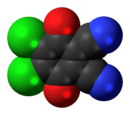2,3-Dichloro-5,6-dicyano-1,4-benzoquinone
| |||
| Names | |||
|---|---|---|---|
Other names
| |||
| Identifiers | |||
| 84-58-2 | |||
| Abbreviations | DDQ | ||
| ChemSpider | 6517 | ||
| EC Number | 201-542-2 | ||
| Jmol interactive 3D | Image | ||
| PubChem | 6775 | ||
| RTECS number | GU4825000 | ||
| |||
| |||
| Properties | |||
| C8Cl2N2O2 | |||
| Molar mass | 227.00 g·mol−1 | ||
| Appearance | yellow to orange powder | ||
| Density | 1.7g/cm3 | ||
| Melting point | 210 to 215 °C (410 to 419 °F; 483 to 488 K) (decomposes) | ||
| Boiling point | 301.8 °C (575.2 °F; 575.0 K) at 760mmHg | ||
| reacts | |||
| Hazards | |||
| R-phrases | R25 R29 | ||
| S-phrases | S22 S24/25 S37 S45 | ||
| Flash point | 136.3 °C (277.3 °F; 409.4 K) | ||
| Except where otherwise noted, data are given for materials in their standard state (at 25 °C [77 °F], 100 kPa). | |||
| | |||
| Infobox references | |||
2,3-Dichloro-5,6-dicyano-1,4-benzoquinone (or DDQ) is the chemical reagent with formula C6Cl2(CN)2O2. This oxidant is useful for the dehydrogenation of alcohols,[2] phenols,[3] and steroid ketones[4] in organic chemistry. DDQ decomposes in water, but is stable in aqueous mineral acid.[5]
Preparation
Synthesis of DDQ involves cyanation of chloranil. Thiele and Günther first reported a 6-step preparation in 1906.[6] The substance did not receive interest until its potential as a dehydrogenation agent was discovered. A single-step chlorination from 2,3-dicyanohydroquinone was reported in 1965.[7]
Reactions
The reagent removes pairs of H atoms from organic molecules. The stoichiometry of its action is illustrated by the conversion of tetralin to naphthalene:
- 2 C6Cl2(CN)2O2 + C10H12 → 2 C6Cl2(CN)2(OH)2 + C10H8
The resulting hydroquinone is poorly soluble in typical reaction solvents (dioxane, alkanes), which facilitates workup.
Dehydrogenation
Aromatization
Oxidative coupling
Safety
DDQ reacts with water with release of hydrogen cyanide (HCN), which is highly toxic. A low-temperature and weakly acidic environment increases the stability of DDQ.
References
- ↑ 2,3-Dichloro-5,6-dicyano-p-benzoquinone at Sigma-Aldrich
- ↑ Braude, E. A; Linstead, R. P.; Wooldridge, K. R. H. (1956). "593. Hydrogen Transfer. Part IX The Selective Dehydrogenation of Unsaturated Alcohols by High-potential Quinones". Journal of the Chemical Society (Resumed) 1956: 3070–3074. doi:10.1039/JR9560003070.
- ↑ Becker, H. D. (1965). "Quinone Dehydrogenation. I. Oxidation of Monohydric Phenols". Journal of Organic Chemistry 30 (4): 982–989. doi:10.1021/jo01015a006.
- ↑ Turner, A. B.; Ringold, H. J. (1967). "Applications of High-potential Quinones. Part I. The Mechanism of Dehydrogenation of Steroidal Ketones by 2,3-Dichloro-5,6-Dicyanobenzoquinone". Journal of the Chemical Society C: Organic 1967: 1720–1730. doi:10.1039/J39670001720.
- ↑ Derek R. Buckle, Steven J. Collier, Mark D. McLaws "2,3-Dichloro-5,6-dicyano-1,4-benzoquinone" in E-EROS ENCYCLOPEDIA OF REAGENTS FOR ORGANIC SYNTHESIS, 2005. doi:10.1002/047084289X.rd114.pub2
- ↑ Thiele, J.; Günther, F. (1906). "Ueber Abkömmlinge des Dicyanhydrochinons". Justus Liebig's Annalen der Chemie 349 (1): 45–66. doi:10.1002/jlac.19063490103.
- ↑ Walker, D.; Waugh, T. D. (1965). "2,3-Dichloro-5,6-Dicyanobenzoquinone (DDQ). A New Preparation". The Journal of Organic Chemistry 30 (9): 3240–3240. doi:10.1021/jo01020a529.
- ↑ Brown, W.; Turner, A. B. (1971). "Application of High-potential Quinones. 7. Synthesis of Steroidal Phenanthrenes by Double Methyl Migration". Journal of the Chemical Society C: Organic 1971: 2566–2572. doi:10.1039/J39710002566.
- ↑ Zhang, Y.; Li, C. J. (2006). "DDQ-Mediated Direct Cross-Dehydrogenative-Coupling (CDC) between Benzyl Ethers and Simple Ketones". Journal of the American Chemical Society 128 (13): 4242–4243. doi:10.1021/ja060050p.




